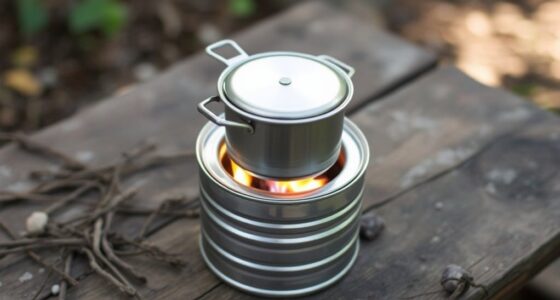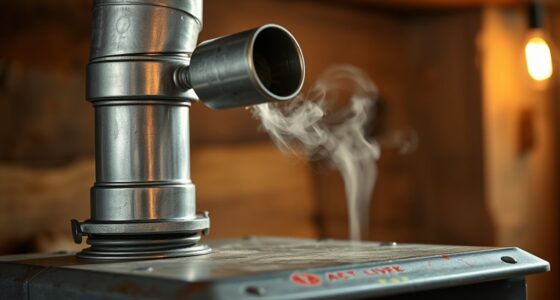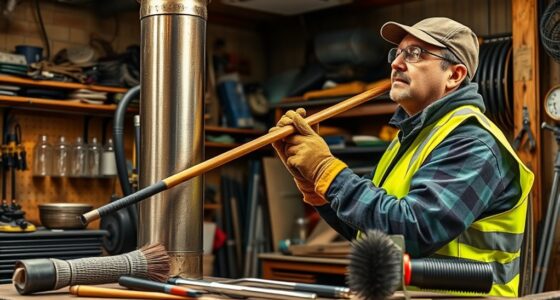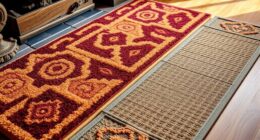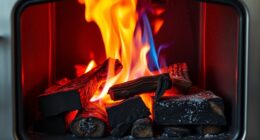To build a noncombustible hearth pad, start by choosing fire-resistant materials like concrete, brick, or fireproof boards. Measure your area precisely, then prepare a clean, level surface, adding a vapor barrier if needed. Follow manufacturer instructions for installation, ensuring materials are handled safely and securely fastened. Allow the components to cure properly before use. For detailed steps to create a durable, safe surface, continuing will provide you with all the essential guidance.
Key Takeaways
- Select certified fire-resistant materials like concrete, brick, or fireproof boards for safety and durability.
- Measure and mark the installation area precisely, then prepare a clean, level surface, adding vapor barriers if needed.
- Follow manufacturer instructions to properly install and secure fireproof materials, using appropriate adhesives and tools.
- Handle all materials with caution, wear protective gear, and ensure proper ventilation throughout the process.
- Allow sufficient curing time, check for stability, and verify the surface is level and securely bonded before use.
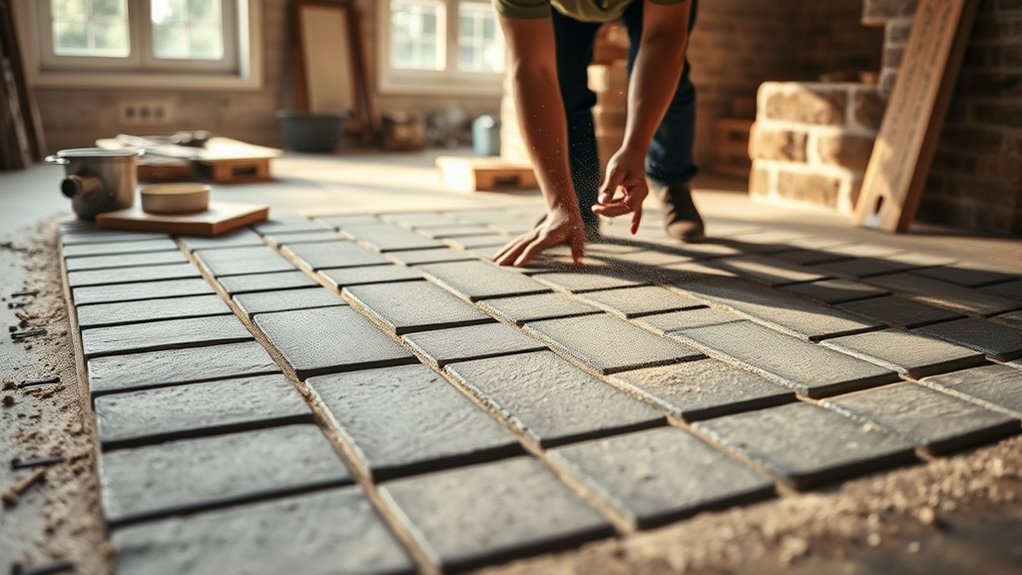
Are you ready to create a safe, durable base for your fireplace? Building a noncombustible hearth pad is essential for both safety and aesthetic appeal. The first step involves selecting the right fire resistant materials. These materials are specifically designed to withstand high temperatures and prevent heat transfer, making them ideal for protecting your flooring and surrounding structures. Common options include concrete, brick, tile, or specially rated fireproof boards. When choosing your materials, always prioritize those with certified fire-resistant properties to ensure maximum safety. Remember, installation safety is paramount; following proper procedures minimizes risks and guarantees a sturdy, reliable base.
Select certified fire-resistant materials like concrete, brick, or tile for a safe, durable hearth pad.
Start by measuring the area where you want your hearth pad. Use a tape measure to mark the exact dimensions on the floor. Once you have your measurements, prepare the surface by cleaning it thoroughly, removing dust and debris. A clean, level surface ensures your hearth pad will sit evenly and adhere properly. Next, lay down a vapor barrier if needed, especially if you’re installing over a concrete slab. This prevents moisture from seeping through and damaging your hearth over time. When working with fire resistant materials like concrete or fireproof boards, follow manufacturer instructions carefully. Wear protective gear and handle materials with care to ensure safe installation safety practices.
If you’re using concrete, mix it according to the manufacturer’s specifications, then pour and spread it evenly within your marked area. Use a trowel to smooth the surface and create a level, flush finish. For tile or brick, lay down a bed of fireproof mortar or adhesive, then carefully place the tiles or bricks, ensuring consistent spacing. Press firmly to secure each piece and avoid gaps that could compromise the integrity of the hearth. If using fireproof boards, cut them to size with a saw designed for the material, then fasten them to a sturdy, noncombustible backing with appropriate screws or anchors. Always double-check that the surface remains level throughout the process. Additionally, consider ventilation considerations to ensure safe working conditions and proper curing of materials.
Throughout this process, prioritize installation safety at every step. Keep your workspace clear of obstructions, wear protective gear, and handle all materials with caution. Ensure proper ventilation if you’re working with adhesives or concrete mixes. Once your hearth pad is installed, give it ample time to cure or set before using your fireplace. This ensures the materials are fully bonded and able to withstand heat without cracking or shifting. By selecting the right fire resistant materials and following safety guidelines, you create a robust, noncombustible foundation that’s both safe and visually appealing—perfect for enjoying your fireplace with peace of mind.
Frequently Asked Questions
What Tools Are Essential for Building a Hearth Pad?
You’ll need essential tools like a masonry saw or angle grinder, trowels, a level, and measuring tape for your hearth pad. Make certain you have fireproof materials and proper insulation techniques on hand. A rubber mallet helps with adjustments, while a waterproofing brush ensures durability. Using these tools, you can accurately cut, lay, and secure your noncombustible materials, guaranteeing a safe, high-quality hearth pad.
How Do I Ensure the Pad Is Level and Even?
You guarantee the pad is level and even by using a spirit level and straightedge for accurate readings. Apply leveling techniques like adjusting the base layers or adding shims to achieve surface consistency. Continuously check with your level as you work, making small adjustments until the entire surface is flat. This approach guarantees a stable, safe hearth pad that’s properly aligned and ready for installation.
What Materials Are Best for Durability and Safety?
You should choose fire-resistant materials like concrete, brick, or slate for your hearth pad, as they offer long-lasting durability and safety. These materials withstand high temperatures and resist cracking over time. Avoid combustible options to guarantee safety. Opt for dense, noncombustible surfaces that can handle wear and tear, providing a sturdy foundation for your fireplace while maintaining fire-resistant qualities. This approach guarantees both durability and safety.
How Long Does the Installation Process Typically Take?
The installation process usually takes about one to two days, depending on your project planning and the complexity of your hearth pad. You’ll want to allocate time for preparing the area, measuring, cutting materials, and ensuring everything is level and secure. Rushing can lead to mistakes, so it’s best to set a realistic timeline and gather all necessary tools and materials beforehand. This way, you’ll complete the project efficiently and safely.
Are There Any Building Codes or Permits Needed?
Imagine you’re installing a hearth pad in your living room, and a building inspector visits to check compliance. You’ll need to review local building codes and permit requirements before starting. Many jurisdictions require permits for such projects, especially if they involve structural changes. Failing to obtain necessary permits can lead to fines or safety issues later. Always check with your local building department to guarantee your project meets all codes and permit requirements.
Conclusion
Now that you’ve built your noncombustible hearth pad, you’ve laid a strong foundation like roots anchoring a mighty tree. With this sturdy base, your fireplace becomes a safe, enduring centerpiece in your home. Remember, just as a tree stands tall through storms, your hearth pad guarantees safety and stability for years to come. Keep it maintained, and it’ll serve as the unwavering heart of your cozy space—grounded, reliable, and ready for warmth.





